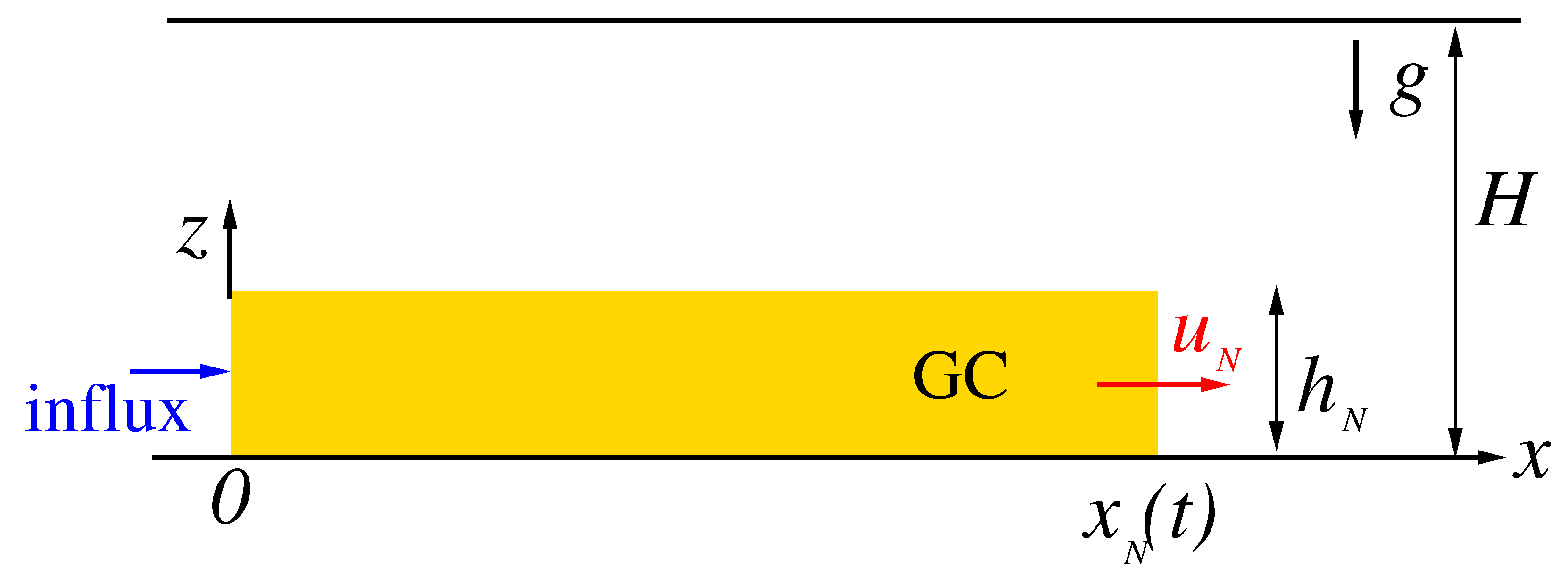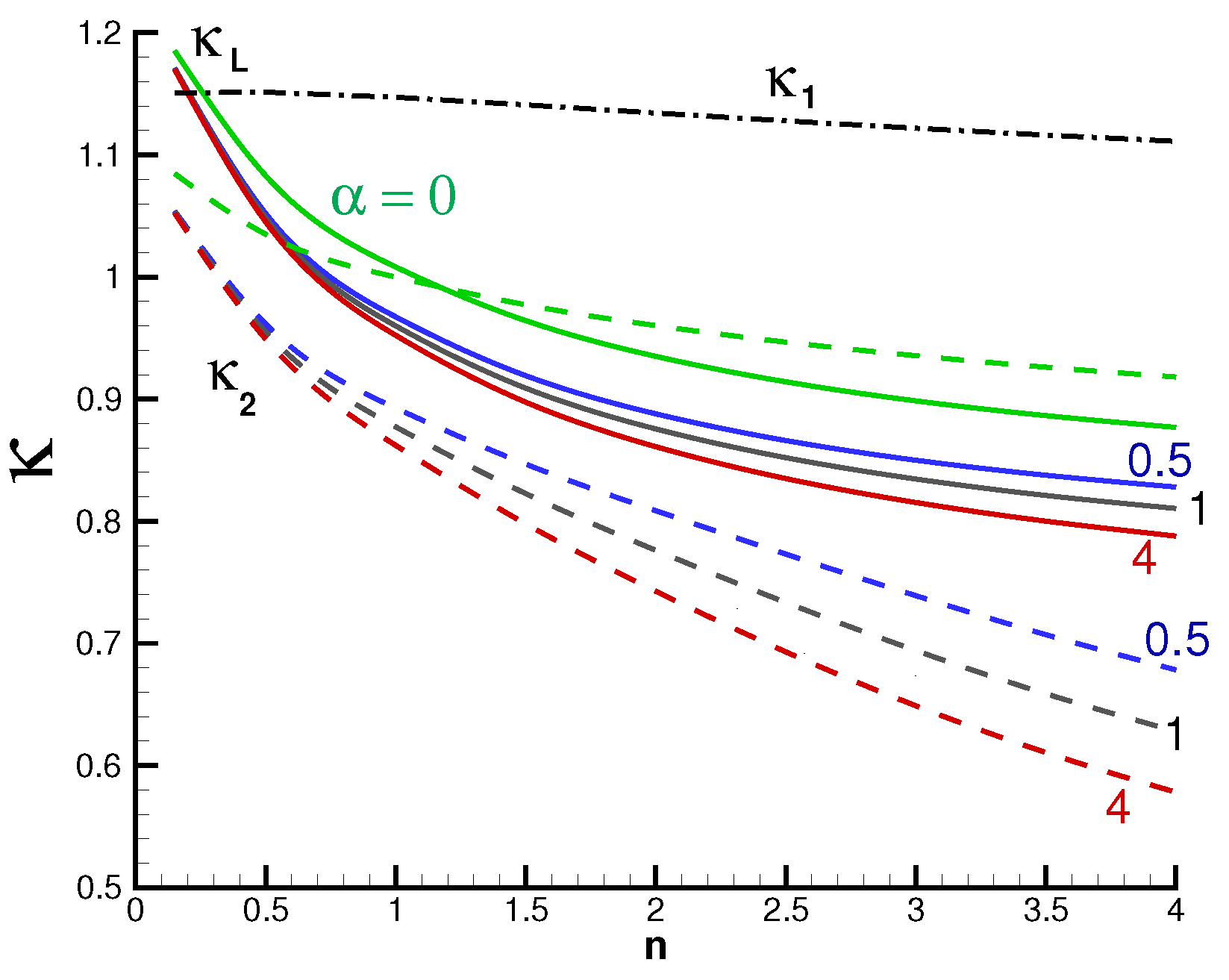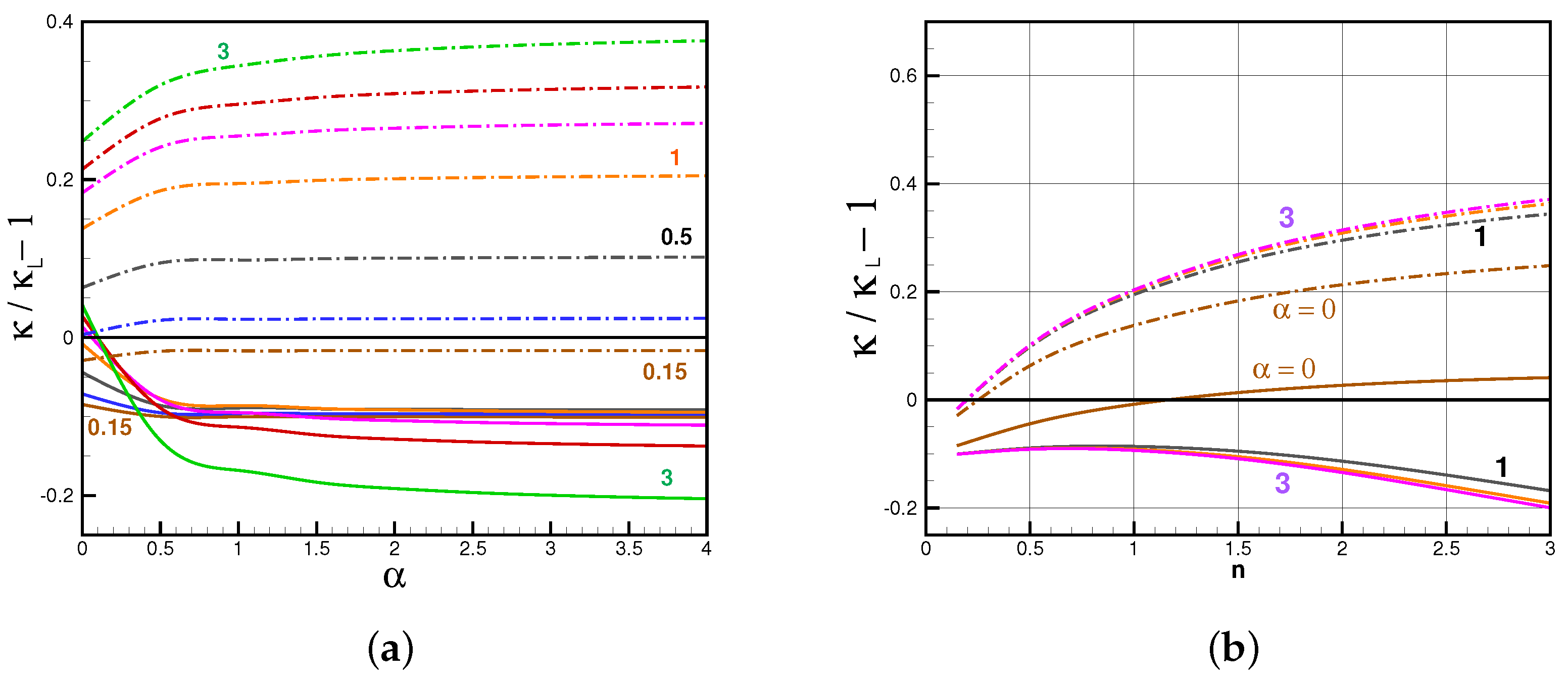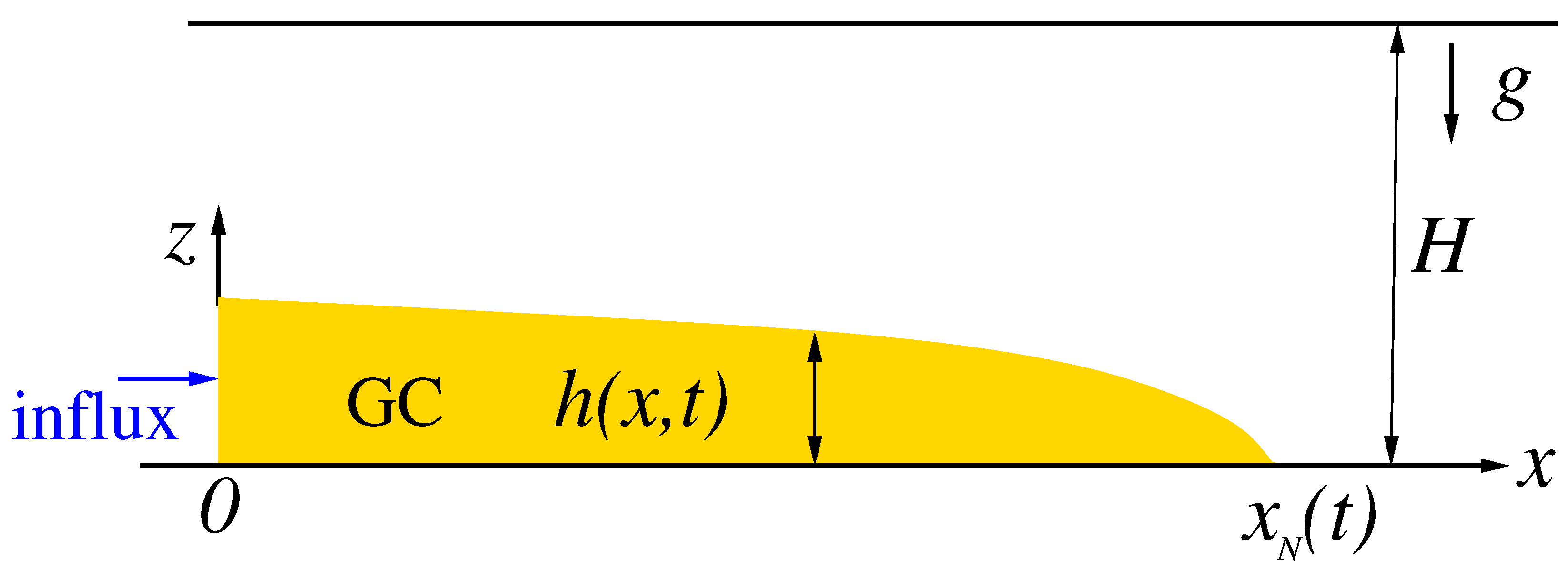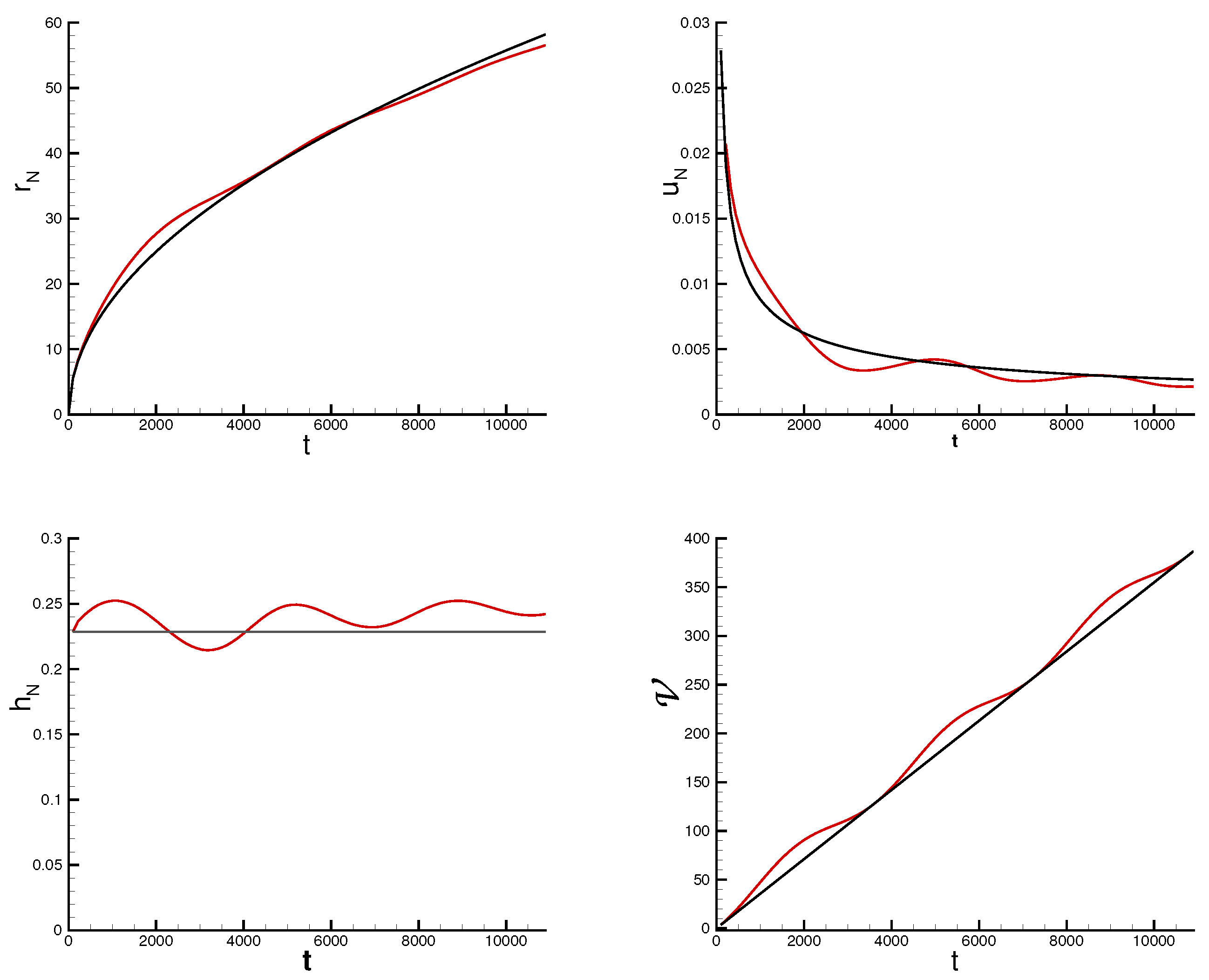1. Introduction
Gravity current (GC) is a generic name for the buoyancy-driven flow of a fluid of one density,
, into an ambient fluid of a different density,
, mostly in the horizontal direction
x (to be distinguished from the mostly vertical buoyancy-driven flows called plumes); see Ref. [
1] and the references therein. The driving buoyancy mechanism is a result of the fact that in a thin layer the vertical acceleration is negligible, and hence the pressure fields are hydrostatic,
; this produce a horizontal pressure gradient
, where
g is the gravitational acceleration,
z is the vertical upward coordinate,
j denotes the ambient and current, and
is the reduced gravity. The buoyancy is balanced by either inertial or viscous effects. Here we consider the so-called viscous GCs, dominated by a buoyancy–viscous dynamic balance and relevant to flows at a small Reynolds number. Viscous GCs have numerous applications in nature and industry, for example, oil spills on the sea, lava, mudslides (Refs. [
2,
3], and soft plastics [
4]). Early investigations were concerned with the flow of Newtonian fluids (e.g., [
5,
6]), and more recent studies have focused attention on the more complex non-Newtonian fluids, in particular with power-law viscosity
, where
n is the behavior index—see (
8)—and
is for a Newtonian fluid (e.g., [
7,
8,
9,
10]).
The theoretical frameworks were the following: (1) the thin-layer lubrication model (Refs. [
5,
6,
8,
10]), which requires the solution of a partial differential equation for the interface
(
x is the direction of propagation and
t is time); (2) the box model, abbreviated as BM (Refs. [
1,
11,
12,
13]), postulates a horizontal interface
and requires the solution of simple initial-value ordinary differential equations; see
Figure 1.
The prototype GC in the published studies is of volume
, where
t is time. Such systems provide a triple advantage. First, the lubrication model is amenable to a similarity transformation that reduces the problem to requiring the solution of an ordinary differential equation. Second, the BM formulation is reduced to some simple algebraic formulas. Third, both models predict propagation of the form
, with exactly the same
(a simple dimensionless function of
and the geometry of the rectangular two-dimensional (2D) or cylindrical axisymmetric (AXI)). These predictions are very convenient for verification and empirical corrections by laboratory experiments. In the typical laboratory experiment (e.g., Refs. [
6,
10,
11,
13,
14]) the viscous fluid (of known properties) is either released from a lock (
case) or slowly injected from a controlled source (
case) over a smooth horizontal surface (the bottom). After a while, a clear-cut thin layer (the GC) will spread out. The shape of the inlet and the lateral walls determines if the spreading is 2D or AXI. The edge of the current,
(or
, is recorded. These measurements are then curve-fitted to the expected
form, and they provide the data
and
(within some ± error). In general, the experiments (1) confirmed the predicted
, within a small error, (2) displayed fair agreement with the
K predicted by the lubrication model, but (3) revealed some notable discrepancies (typically 25% overprediction) with the values of
K predicted by the BM (more details will be given below). The reasons for these discrepancies of the BM have not received much attention, to our knowledge, and no attempts at theoretical improvement of the BM have been made. The fact that the BM predicts exactly the same
as the lubrication model but significantly overpredicts
K is intriguing. Dimensional analysis (Refs. [
15,
16]) indicates the same time scaling for the box and lubrication models, but this does not warrant the existence of a similarity solution. We note that
K is a dimensional constant, and upon a proper scaling it can be reduced to a dimensionless coefficient
of order unity, which is a function of
and the geometry.
This gap of knowledge has motivated the present work: a revisit of the BM, with the aim of improving the predictions. In this context, we emphasize that the BM has merits, which endow this revisit with practical benefits. First, as compared to the lubrication model, the physical balances governing the BM are significantly more transparent and are expressed in simple mathematical formulas, thus providing sharper insights and faster results. Second, when the influx is not a time power (a relevant practical situation), the lubrication model requires a numerical solution of a PDE with initial and non-trivial boundary conditions, while the BM predictions can be obtained by a simple integration of initial-value ODEs. The analysis is complicated by the fact that a convenient scaling of the variables is not available for a GC sustained by a general influx function. This suggests that the BM is a valuable ingredient in the toolkit for the analysis of GC systems.
The present work makes some progress. We must keep in mind that the BM is, essentially, a bold approximation based on instantaneous balances of volume and forces (buoyancy and viscous) over the entire mass of the GC. (This method of analysis is also referred to as “momentum integral;” see Ref. [
17]). The local details of the flow field are replaced by some plausible simplification formulas, which allow easy mathematical manipulations, particularly easy integration over the volume. The accuracy of the results cannot be guaranteed a priori, and therefore BM solutions can be endorsed only after systematic comparisons with more rigorous solutions and/or data (experiments, Navier–Stokes simulations). The similarity solution of the lubrication model is therefore a very convenient benchmark for the BM.
Moreover, the choice of closures/simplifications used in the BM allows for some flexibility. The major assumption of a horizontal interface is a fixed feature, but the BM involves some assumptions about the velocity profile in the layer. We argue that these assumptions did not receive sufficient attention in previous works and suggest that a more careful approach to this issue may improve the accuracy of K. We show that the apparently accepted BM formulation (which we call basic) uses some simplifications for the velocity profiles that are not fully consistent with the physical system, in general. In hindsight, these can be called over-simplifications. We introduce an improved formulation that removes these inconsistencies within an insignificant mathematical complication. Comparisons with the lubrication theory and with data support this version of the BM (which we call “improved”). In other words, for GCs of volume , we can calculate and compare the dimensionless of the basic box, improved box, and lubrication models; and then we also compare them with the experimental . We extend the BM formulation to the general influx and illustrate the application. Overall, the results are satisfactory and can be recommended for further use.
The paper is organized as follows. The major part of the analysis is concerned with power-law volume
because, for such systems, similarity solutions are available for reliable comparisons. The BM predictions are developed for the basic and improved versions, and then they are compared with the similarity solution for the rectangular two-dimensional (2D) and cylindrical axisymmetric (AXI) geometries, in
Section 2 and
Section 3, respectively. A comparison with data from the literature is presented in
Section 4. In
Section 5 the BM for the general time-dependent influx is formulated and tested. Concluding remarks are made in
Section 6.
Appendix A presents the derivation of the improved shear formula,
Appendix B gives some suggestions for scaling, and
Appendix C summarizes the method for obtaining the lubrication model coefficient
.
Figure 1.
Sketch of the box model (BM) system. The volume (per unit width) is . In the self similar flow, . In the axisymmetric geometry, r replaces x and is per radian. are constants.
Figure 1.
Sketch of the box model (BM) system. The volume (per unit width) is . In the self similar flow, . In the axisymmetric geometry, r replaces x and is per radian. are constants.
2. Two-Dimensional Flow
The basic simplification of the BM is that the dense fluid is contained in a rectangular box. The source is at
. The interface of the GC is horizontal, i.e.,
, with a vertical jump at the nose, see
Figure 1. The subscript
N denotes the nose of the GC. The velocity of the fluid in the box is
. In the realistic viscous GC, the velocity is
z dependent and subject to the no-slip condition at the bottom
. The BM
must be interpreted as the depth-averaged velocity. (The no-slip condition will enter the balances as a friction force.) We assume a deep ambient
and hence the effect of the return flow is negligible, and there is no shear at the interface. The balances are performed per unit width.
The volume of the injected fluid is
,
.
represents a GC of fixed volume
q. This time-dependency of
suggests a propagation of the form
where
K and
are positive constants. The major task is to determine
K and
for given influx conditions and given fluid. We use dimensional variables unless stated otherwise.
Consider the kinematic balances. The constant
x-independent
has two important implications. First, total volume conservation
yields
Second, the continuity equation
imposes that
is a linear function of
x. This we express as
where
and we keep in mind that
is of the form
. Moreover, we note that
(the vertical velocity of the interface), and hence, in general, this coefficient is non-zero.
The dynamic balance is between the forces acting on the entire GC in the box from
to
. This is expressed as
where the buoyancy force is given by
and the viscous force due to the shear
at the bottom is provided by
The calculation of
at the bottom is as follows. First, because this is a viscous effect, we must take into consideration the shear in the realistic
velocity in the layer. We recall that the BM velocity is the depth-averaged
where the “hat” (^) is used to emphasize the physical, not averaged velocity. Second, we consider the GC to obey the power-law relationship (see Ref. [
18]) for the dynamic and kinematic viscosities as follows
where
m is the consistency index and
n is the behavior index (or exponent). The cgs dimension of
is
. A fluid is shear-thinning (pseudoplastic) if
, shear-thickening (dilatant) if
, and Newtonian if
(in this case,
, the standard dynamic viscosity of the fluid and
is the standard kinematic viscosity coefficient). Third, we recall that at the bottom
,
. Finally, we seek an approximation to
in terms of the variables of the BM. We argue (see Ref. [
14]) that the shear at
is proportional to the local slope
(the ratio of the depth-averaged velocity to the thickness of the layer). Taking these points into account, and using
, we express the BM approximation of the shear stress at the bottom
where (
3) and (
4) were used and
is a constant. In other words, in the BM balances the shear at the bottom is approximated by
, where
is a constant, to be specified later. Order-of-magnitude arguments (Refs. [
6,
14]) suggest that
is of the order of unity.
Using (
9) the force balance (
5)–(
7) reads
where
We substitute (
1) and (
2) into (
10), and after some algebra find that the force balance is fulfilled when
where
We conclude that the time-power of the propagation is unique. The coefficient K is a product of the following: (a) a dimensional (scale) term which contains and q; (b) a unique dimensionless term which depends on (or ); (c) the ambiguous dimensionless coefficient .
The coefficient is ambiguous because it depends on three unspecified constants: the coefficient for the shear, and the coefficients and for the horizontal velocity profile . The guidelines for the needed closures are that is of the order of 1, , and that in general is non-zero. We consider two practical methods for finalizing the calculation of , as follows:
(1) The basic approach, which has been used for the BM calculation of
K in previous investigations (without exception, to our knowledge), employs the simplest plausible correlation that satisfies the abovementioned guidelines. In this case, the choice is
and
, i.e.,
. Using (
11), we obtain
This closure method is somewhat arbitrary. There is no a priori justification why other constants, e.g., and , should not be used. Conversely, and can be considered adjustable parameters of this model. The reliability of the predicted is debatable.
(2) The improved approach suggests to use additional consistent information, if it is expected to “correct” the previous choice. First, we note that the choice
imposes zero influx at
, which is inconsistent with the
systems. The consistent influx velocity is given by
where (
1) and (
2) were used. The improved velocity profile is therefore
and hence
and
when
.
Next, we recall that
is just a guess based on an order-of-magnitude estimate (Ref. [
14]) of the ratio between
at the bottom and the local slope
(here
u is the depth-averaged velocity). We look at a physical solution for more guidance. The lubrication theory solution for a GC, see
Appendix A, provides a rigorous, more realistic, result for this connection, given by
With these new estimates, we obtain
We conclude that the closures
and
are over-simplifications. The use of other values improves the connection of the model with the physical system, without affecting the mathematical simplicity of the formulation. Moreover, the present model is unique. The clear-cut physical arguments for the setting of
by (
19) and
render the value of
self-contained, with no adjustable parameters.
We note that the factor
decreases with
n from 1 to
, see
Figure 2. This represents the contribution of the
-profile of the velocity to
. The simple change of the linear-profile over-simplification
for the more physical parabolic shape is already a fairly significant improvement of the over-predictions of the basic BM, even for Newtonian fluids
. This correction is slightly less significant for the AXI system. We also note the non-linear behavior of the system. The change to parabolic profile yields a strong increase in
(factor 3 for the Newtonian
), but the influence on
is only a few percent (This illustrates why a BM may give fairly good predictions in spite of bold simplifications. Unfortunately, this argument may also work in the opposite direction). The coefficient
of the basic model is recovered for
; in this case, the difference between
and
is only due to
.
Although we have invested more physical considerations into the derivation of
, there is no guarantee for a more accurate solution in general. The stringent test involves a comparison with a more rigorous solution. The lubrication theory analysis of the GC (see Ref. [
8]) provides the similarity solution
where
is obtained numerically. The important point is that the BM and the rigorous solution are in full agreement concerning the value of
, see (
12), and the form of the prefactor of
; the only difference is in the value of the coefficient
(which is expected to be of the order 1). The coefficient
is a by-product of the solution of a second-order differential equation for the
-dependency profile of the height of the GC, for a given pair of
and
n (some details are given in
Appendix C). For comparison, we fix the values of
and
.
Figure 3 shows
and
. We observe that
reproduces well the trends of
with
n and
, and in general, the discrepancies are smaller than for
.
Figure 2.
vs. n. Blue line for 2D, red line for AXI. Also shown the asymptotes and , respectively.
Figure 2.
vs. n. Blue line for 2D, red line for AXI. Also shown the asymptotes and , respectively.
Figure 3.
Two-dimensional system. (solid line) and (dashed line) vs. n for various , and (dashdot line, independent of ).
Figure 3.
Two-dimensional system. (solid line) and (dashed line) vs. n for various , and (dashdot line, independent of ).
Figure 4 display the relative differences of
and
from
. For each value of
n, the error (absolute value) increases strongly from
to
(approximately); thereafter, the increase with
is mild.
We note that Ref. [
11] presented comparisons of
(called
in that paper) for the basic BM and lubrication model for
and
, Figure 9 of that paper. The novelty here is the introduction of the improved BM; the question is whether
is a more reliable result than
.
Figure 4 indicates that the answer is in the affirmative.
Figure 4.
BM 2D, results of (dash dot line) and (solid line). (a) vs. for various n = 0.15, 0.5, 1, 1.5, 2, 3; (b) vs. n for various .
Figure 4.
BM 2D, results of (dash dot line) and (solid line). (a) vs. for various n = 0.15, 0.5, 1, 1.5, 2, 3; (b) vs. n for various .
3. Axisymmetric Flow
The basic simplification of the BM is that the dense fluid is contained in a cylinder box. The source is at the axis
. The interface of the GC is horizontal, i.e.,
, see
Figure 1. The balances are performed per radian (i.e., we omit the coefficient
.
The volume of the injected fluid is
, which suggests a propagation of the form
where
K and
are positive constants.
Consider the kinematic balances. The constant
r-independent
has two important implications. First, total volume conservation
yields
Second, the continuity equation
imposes that
is of the form
. This we express as
where
and we keep in mind that
is of the form
.
The dynamic balance is between the forces acting on the entire GC in the cylinder box from 0 to
. This is expressed, again, as
where the buoyancy force is given by
and the viscous force due to the shear at the bottom is calculated by
The dynamic and kinematic viscosities of the current are as discussed in the previous section; upon replacing
x by
r, the BM simplification is expressed as
where
is a constant of the order of unity.
Using (
31) the force balance reads
where
We substitute (
24) and (
25) into (
32), and after some algebra find that the force balance is fulfilled when
where
We conclude that the time-power of the propagation is unique, but the prefactor K contains the ambiguous dimensionless coefficient . As in the 2D case, we consider two closure assumptions.
(1) The basic approach employs
and
. Consequently, using (
33), we obtain
(2) The improved approach. The choice
implies unrealistic influx at (and near) the axis
when
. We noticed that the continuity equation admits a solution of the form
. The influx velocity is given by
Using
, (
24)–(
25), and some algebra, we find that the improved radial velocity, which satisfies the boundary conditions at
and
is given by
The improved velocity profile is
and hence
The small
(we use 0.05) mimics the finite radius of a realistic source, and is needed to avoid the singularity at the axis, and then the numerical evaluation of
is straightforward. The improved
is provided by (
21) by the same argument. With these new estimates, we obtain
The deficiencies of the basic model and advantages of the improved model outlined for the 2D case (
Section 2) carry over to the AXI system.
The stringent test is a comparison with the lubrication theory (see Refs. [
10,
13]), which provides the similarity solution
where
is obtained numerically (see
Appendix C). The important point is that the BM and the rigorous solution are in full agreement concerning the value of
, see (
34), and prefactor of
; the only difference is in the coefficient
.
Figure 5 shows the behavior of
and
as functions of
n, and
Figure 6 displays the relative differences of
and
from
. The basic
is a slightly more accurate approximation for
, but for larger
n the error of the improved
is about two times smaller.
We note that [
13] presented values of
for the basic BM and lubrication model for
and
(Figure 2 in that paper). The novelty here is the introduction of the improved BM; the question is whether
is more accurate than
. As in the 2D case, the answer is in the affirmative.
Figure 5.
AXI system. (solid line) and (dashed line) vs. n for various , and (dashdot line, independent of ).
Figure 5.
AXI system. (solid line) and (dashed line) vs. n for various , and (dashdot line, independent of ).
Figure 6.
BM AXI, results of (dash-dot line) and (solid line): (a) vs. for various n = 0.15, 0.5, 1, 1.5, 2, 3; (b) as a function of n for various .
Figure 6.
BM AXI, results of (dash-dot line) and (solid line): (a) vs. for various n = 0.15, 0.5, 1, 1.5, 2, 3; (b) as a function of n for various .
6. Conclusions
We revisited the BM predictions for viscous gravity currents created by an influx over a horizontal boundary. We showed that the basic version (used in previously published studies) contains, in general, two inconsistencies with the physical systems: (a) zero velocity at the source; (b) oversimplified connection between the shear at the bottom and . Moreover, the underlying arguments of this model are somewhat arbitrary, and actually contains two adjustable parameters. We presented an improved BM version that corrects these deficiencies while preserving the simplicity and versatility of the model. The prediction is unique.
The BM is, in general, an unreliable tool, unless verified by some stringent tests over a wide range of parameters. Here we performed such tests for systems with power-law influx for which rigorous analytical solutions of the reliable lubrication model formulations, as well as laboratory data, are available in the literature. These tests confirm the value of the improved model as a prediction tool.
The interpretation of the results for the case requires some care. Since the volume is fixed, the intrinsic origin for t is missing. The similarity solution admits an arbitrary time shift const. to a virtual origin. Physically, this reproduces an initial slumping phase during which the flow adjusts to the similarity behavior.
A significant advantage of the BM is the applicability to general (not power law) influx. For such cases, the lubrication-theory formulation is not amenable to analytical reduction (such as similarity behavior), and hence only numerical solutions of the PDEs can be used for predictions. The present analysis is expected to motivate experimental studies of systems with various influx functions (not powers of t) for Newtonian and power-law viscosities and the verification and improvement of the new predictions. The present BM seems amenable to various extensions, such as flow in confined gaps and over inclined walls, surface tension effects, and more general non-Newtonian rheology. These extensions require dedicated investigations concerning formulation and verification, and are left for future work.
The improved BM provides quick qualitative and quantitative answers to a wide range of systems, and is thus recommended as a convenient platform for the analysis of practical flows in nature and industry, with future incorporation of additional effects (such as particle sedimentation, heat exchange, curved bottom).
